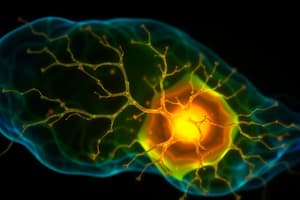Podcast
Questions and Answers
What is lateral inhibition and why was it first studied in the Limulus?
What is lateral inhibition and why was it first studied in the Limulus?
Lateral inhibition is the capacity of an excited neuron to reduce the activity of its neighbors. It was first studied in the Limulus because it illustrates how retinal inhibition works.
Explain the Hermann Grid.
Explain the Hermann Grid.
The Hermann Grid creates an illusion due to lateral inhibition, where neurons at the intersections receive more inhibition, making them appear darker compared to the corridors.
Explain Mach Bands.
Explain Mach Bands.
Mach Bands are visual effects where lighter bands appear around shadows due to differential inhibitions from light and dark areas, providing sharper boundaries.
Explain simultaneous contrast.
Explain simultaneous contrast.
What is White's Illusion?
What is White's Illusion?
What do the receptive fields look like in the optic nerve (ganglion cells) and LGN?
What do the receptive fields look like in the optic nerve (ganglion cells) and LGN?
What is the difference between excitatory-center, inhibitory-surround receptive fields and inhibitory-center, excitatory-surround receptive fields?
What is the difference between excitatory-center, inhibitory-surround receptive fields and inhibitory-center, excitatory-surround receptive fields?
Explain center-surround antagonism.
Explain center-surround antagonism.
Describe the nature of simple cortical cells, complex cortical cells, and end-stopped cortical cells, and the stimuli they are responsive to.
Describe the nature of simple cortical cells, complex cortical cells, and end-stopped cortical cells, and the stimuli they are responsive to.
Flashcards are hidden until you start studying
Study Notes
Lateral Inhibition
- Lateral inhibition refers to the capacity of an excited neuron to inhibit its neighboring neurons, enhancing contrast in visual perception.
- This phenomenon was first examined in the Limulus (horseshoe crab) due to its simple visual system, allowing for clearer observations of neuronal interactions.
Hermann Grid
- The Hermann Grid illusion occurs because neurons at grid intersections experience heightened lateral inhibition compared to those along corridors.
- This illusion disappears when observed directly, as the fovea’s smaller receptive fields reduce the impact of lateral inhibition.
Mach Bands
- Mach Bands create an illusion of enhanced brightness at the edges of a shadow, providing sharper visual boundaries.
- Lighter areas adjacent to darker regions receive stronger lateral inhibition, making them appear even brighter than uniformly lit areas.
Simultaneous Contrast
- In simultaneous contrast, gray boxes surrounded by lighter backgrounds receive increased inhibition, making them appear darker.
- Conversely, when surrounded by darker areas, the inhibition effect is diminished, altering perceived brightness.
White's Illusion
- White's Illusion demonstrates that lateral inhibition alone cannot explain certain visual effects due to the influence of "belongingness," where an area's appearance is affected by its perceived relationship to surrounding elements.
Receptive Fields in the Optic Nerve and LGN
- Receptive fields correspond to specific sensory regions that trigger neuronal firing when stimulated.
- Approximately 90% of the information from the optic nerve is transmitted to the LGN with minimal alteration from the retina.
Receptive Field Types
- Excitatory-center, inhibitory-surround receptive fields result in increased neuronal firing when the center is stimulated.
- Conversely, inhibitory-center, excitatory-surround receptive fields show reduced firing in response to center activation.
Center-Surround Antagonism
- Center-surround antagonism describes how neuronal response initially increases with light exposure in the receptive field but eventually diminishes as more of the field is illuminated.
Cortical Cells Responses
- Simple cortical cells are primarily responsive to light stimuli arranged in specific orientations.
- Complex cortical cells respond optimally to lines that move in particular directions.
- End-stopped cortical cells react to lines of a specific length and to moving corners or edges.
Studying That Suits You
Use AI to generate personalized quizzes and flashcards to suit your learning preferences.


